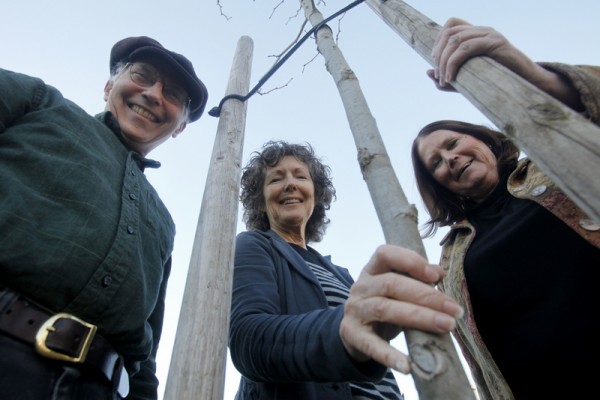
Petaluma Good neighbors George Beeler, Teresa Barrett and Pat Riley (l to r) show off one of the trees they tend on Petaluma High School's campus. (Beth Schlanker / Press Democrat)
By SHELDON BERMONT / Petaluma Correspondent
Steve Schramm had no problem embracing the mixed-use location concept 11 years ago when he and his wife bought their house, just blocks away from Petaluma High School.
After all, what could be more quaint and Norman Rockwellesque than seeing the high school marching band in full uniform, rehearsing on the football field in the fall, or watching the kids as they went to and from classes.
The idyllic Americana backdrop had to be a point-of-sale for Schramm and 60 or so others who knowingly moved into a scenario straight out of American Graffiti. However, as Schramm says, it was only natural that, with 1,300 energetic teenagers on campus, issues such as loitering, littering and noise would arise and need addressing.
The Petaluma Good Neighbor Association was formed to deal with those and other challenges involved with living next door to a high school.
After Schramm and some of his neighbors had had the preliminary “across-the-back-fence conversations/complaint sessions,” they decided to approach the school to deal with a collection of issues that had become a neighborhood nuisance.
Schramm credits George Beeler, a neighborhood resident of 10 years, for his suggestion last February that they approach the school’s administration as an organized group. And, in the inception stages, they also wanted to be sure they were received as a group capable of making its presence known in a positive capacity, not just as a bunch of grouchy complainers.
Their strategy was also intrinsic in the name they chose, Petaluma Good Neighbor Association. They wanted a name that would allow for other neighborhoods to organize and follow their pro-active blueprint.
Members of the newly formed group brought their list of issues to Frank Lynch and Marilyn Stratford, interim co-principals at Petaluma High. Schramm says he was extremely impressed with their cordial and helpful reaction style. Problem-solving plans were quickly put into action.
Lynch solved the loitering issue himself by making regular walking tours of the campus perimeter part of his daily regimen. This helped him ensure students had legitimate reasons for being on or around school grounds.
The next step was dealing with the littering complaint. Co-principal Lynch made more garbage cans available and meets regularly with students to make sure that areas around the campus boundaries stay policed.
The third, and possibly trickiest, complaint was the noise issue. The PA system designed to make school announcements was audible well into the surrounding neighborhood. The sound, as Schramm describes it, “percolated” up the hill to the western side of the campus. The volume actually increased as it travelled because of natural acoustics, much to the consternation of home-owners.
The solution: deciding to use only the speakers that were inside the building and inner campus hallways. The speakers facing outward were designated for field and sports activities only.
Problems were solved, all without the psychodrama that usually accompanies group complaints.
“It’s a really good group,” said co-principal Lynch. “We talk about solutions to ensure that we stay good neighbors. And we’re going to continue to address concerns by holding meetings twice a year.”
When asked to explain the back story to the association’s refreshingly non-adversarial style of problem-solving, Schramm, 56, says, “I don’t think there’s anyone in the group who forgets what it’s like to be a kid.”
In addition to addressing complaints, the neighbors’ group gathered its volunteer forces to assist in a campus beautification project. They mulched and attended to a grove of 15 trees planted along the Fair St. corridor that originally were donated by Petaluma’s Rotary Club.
Not a bad list of accomplishments for a group in existence less than a year. Future plans are now being discussed in association meetings, which take place every three to four months.
“With enrollment projections soaring to 1,700 students over the next few years, new challenges will present themselves,” Schramm says.
“Neighbors have to be involved. Personally, I think that concept has been lost in the last generation.
“I remember being a 12-year-old, sitting on my grandfather’s porch back in Chicago – watching neighbors interacting with the community in a positive way.”
